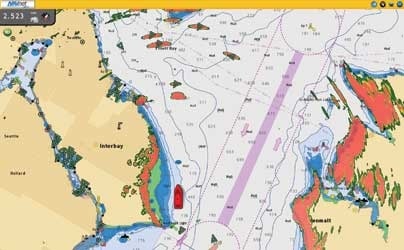
DSC (digital selective calling) is at the heart of the distress function built into all VHF radios today. With a DSC-equipped radio, an MMSI (marine mobile service identity) number, essentially the “phone number” of your radio, and a GPS attached, distress calls can be tracked to your boat position.
The same mechanics work for nonemergency communication. DSC allows you to call another boat with their MMSI on a specific channel, in relative privacy. Or exchange lats/longs, which is called position polling. And MMSIs are becoming more useful all the time, though anglers have been slow to catch on.
With DSC, you can call another VHF radio, and it will ring like a telephone. The essential link is the MMSI number in the VHF “phone book.”
DSC use requires some advance work – you initially need somebody else’s MMSI number and must enter it manually, either ahead of time or when the call is made on the VHF. It’s not that tough. Most VHF radio manufacturers have simplified the entry process.
“We use the rotary knob, a twist and click, so when the field comes up, 0 to 9, you select and click,” explains Jim McGowan of Raymarine.
So let’s say Moe has entered Larry’s MMSI number into his VHF at the dock that morning. Later when they are both on the water, Moe wants to know where Larry is fishing, so using the number he entered, he polls Larry for his position. When his radio rings, Larry grants permission and his position pops up on Moe’s chart plotter.
If Moe then wants to call Larry to see what Larry’s catching but doesn’t want Curly to hear their conversation, he selects “Larry’s Boat” from his phone book and initiates a call, specifying the channel on which their conversation will take place.
They are using two pieces of equipment, a chart plotter and a VHF radio to make this work, and it’s a little clumsy.
There are a few solutions to this currently, none of them entirely seamless.

Standard Horizon offers combination chart plotters/VHF radios, the 7-inch CPV350 and 12-inch CPV550. Only one unit needs to be installed to have the chart plotter and VHF work together. But the MMSI numbers still need to be entered manually.
There’s another option for capturing MMSI numbers. After Larry sends his position to Moe, Larry decides he should tell Moe not to bother joining him unless Moe has plenty of chum. Larry doesn’t have Moe’s MMSI in his phone list, but since his radio has a call log (a history of incoming DSC calls) and Moe recently requested his position, that call has been logged, and it includes the MMSI. Larry selects that call from his log, saves it to his phone book and renames it “Moe’s Boat.” Now he’s captured Moe’s MMSI number and initiates the call to fill him in on the grouper bite.
According to Navico’s Don Korte, Lowrance’s new LVR-250 has automated this procedure. “The display on the radio will tell you the MMSI of the person calling, and if he is already a buddy, it will display the name you’ve assigned him. If he’s not on your phone list, it will ask if you want to store that number. You answer ‘yes’ and assign it a name in your buddy list.”
What’s missing is the ability to pick up the MMSI number off the chart plotter and initiate the call.
Here, the Automatic Identification System (AIS) comes in, and communication based on MMSI numbers is about to become more elegant. “AIS will be the catalyst because the MMSI is such an important part of that system,” says McGowan.
AIS is the VHF utility that transmits information about a boat – its size, name, heading, speed and MMSI number – to any boat with an AIS receiver. Because the AIS transmits an MMSI, it should be simple to click on an AIS icon on the plotter screen and initiate a VHF call. That’s where the future leads.
Simrad appears to be ahead of the curve on this one. According to product expert David Sheekey, Simrad’s RS80 series VHF radios, in combination with the AI50 AIS, eliminate the need to manually deal with MMSI numbers. “With software we released six months ago, you can cursor a ship you want to call. The AI50 sends the MMSI to the radio. Then you program the call and verify it on the VHF,” he says.
Other manufacturers of VHF radios are, like Simrad, writing their own software to integrate AIS with VHF calling. That’s necessary because, while NMEA 0183 and 2000 transfer data effectively, those protocols are not so handy with instructions. It’s up to the manufacturers to create software that transfers the instructions from the plotter to the VHF. Another wrinkle: FCC rules require that VHF calls be initiated from an approved radio, so it’s not possible to place a call directly from the plotter screen. Thus the verification step is necessary.
Garmin, which recently released the NMEA 2000-equipped VHF 200, has developed version 5.0 software to integrate its new radio and the company’s family of network-enabled chart plotters. Greg DeVries, director of marine sales, explains, “With this software in conjunction with AIS, you can call up a boat on our touch screen, touch the target, bring up the information, send the MMSI information to the radio, then verify to make the call. You don’t haven’t go through the menu on the radio for a direct-link call on VHF.”









